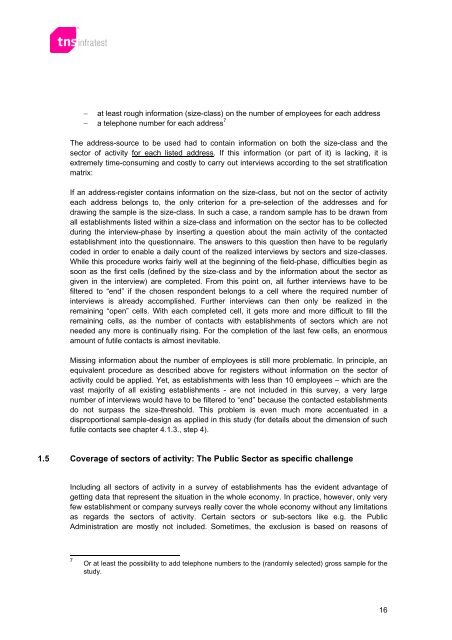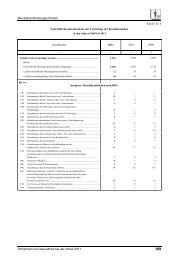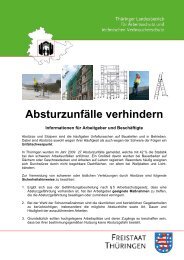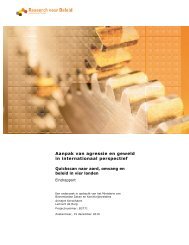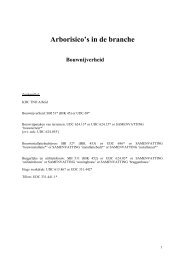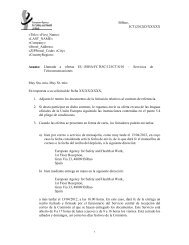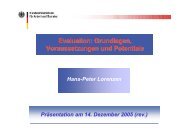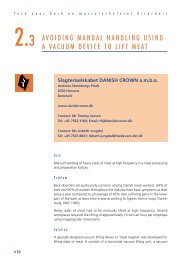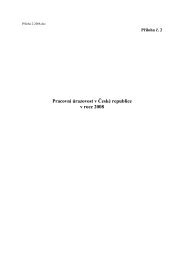ESENER-PSR 2009 - European Agency for Safety and Health at Work
ESENER-PSR 2009 - European Agency for Safety and Health at Work
ESENER-PSR 2009 - European Agency for Safety and Health at Work
Create successful ePaper yourself
Turn your PDF publications into a flip-book with our unique Google optimized e-Paper software.
<strong>at</strong> least rough in<strong>for</strong>m<strong>at</strong>ion (size-class) on the number of employees <strong>for</strong> each address<br />
a telephone number <strong>for</strong> each address 7<br />
The address-source to be used had to contain in<strong>for</strong>m<strong>at</strong>ion on both the size-class <strong>and</strong> the<br />
sector of activity <strong>for</strong> each listed address. If this in<strong>for</strong>m<strong>at</strong>ion (or part of it) is lacking, it is<br />
extremely time-consuming <strong>and</strong> costly to carry out interviews according to the set str<strong>at</strong>ific<strong>at</strong>ion<br />
m<strong>at</strong>rix:<br />
If an address-register contains in<strong>for</strong>m<strong>at</strong>ion on the size-class, but not on the sector of activity<br />
each address belongs to, the only criterion <strong>for</strong> a pre-selection of the addresses <strong>and</strong> <strong>for</strong><br />
drawing the sample is the size-class. In such a case, a r<strong>and</strong>om sample has to be drawn from<br />
all establishments listed within a size-class <strong>and</strong> in<strong>for</strong>m<strong>at</strong>ion on the sector has to be collected<br />
during the interview-phase by inserting a question about the main activity of the contacted<br />
establishment into the questionnaire. The answers to this question then have to be regularly<br />
coded in order to enable a daily count of the realized interviews by sectors <strong>and</strong> size-classes.<br />
While this procedure works fairly well <strong>at</strong> the beginning of the field-phase, difficulties begin as<br />
soon as the first cells (defined by the size-class <strong>and</strong> by the in<strong>for</strong>m<strong>at</strong>ion about the sector as<br />
given in the interview) are completed. From this point on, all further interviews have to be<br />
filtered to “end” if the chosen respondent belongs to a cell where the required number of<br />
interviews is already accomplished. Further interviews can then only be realized in the<br />
remaining “open” cells. With each completed cell, it gets more <strong>and</strong> more difficult to fill the<br />
remaining cells, as the number of contacts with establishments of sectors which are not<br />
needed any more is continually rising. For the completion of the last few cells, an enormous<br />
amount of futile contacts is almost inevitable.<br />
Missing in<strong>for</strong>m<strong>at</strong>ion about the number of employees is still more problem<strong>at</strong>ic. In principle, an<br />
equivalent procedure as described above <strong>for</strong> registers without in<strong>for</strong>m<strong>at</strong>ion on the sector of<br />
activity could be applied. Yet, as establishments with less than 10 employees – which are the<br />
vast majority of all existing establishments - are not included in this survey, a very large<br />
number of interviews would have to be filtered to “end” because the contacted establishments<br />
do not surpass the size-threshold. This problem is even much more accentu<strong>at</strong>ed in a<br />
disproportional sample-design as applied in this study (<strong>for</strong> details about the dimension of such<br />
futile contacts see chapter 4.1.3., step 4).<br />
1.5 Coverage of sectors of activity: The Public Sector as specific challenge<br />
Including all sectors of activity in a survey of establishments has the evident advantage of<br />
getting d<strong>at</strong>a th<strong>at</strong> represent the situ<strong>at</strong>ion in the whole economy. In practice, however, only very<br />
few establishment or company surveys really cover the whole economy without any limit<strong>at</strong>ions<br />
as regards the sectors of activity. Certain sectors or sub-sectors like e.g. the Public<br />
Administr<strong>at</strong>ion are mostly not included. Sometimes, the exclusion is based on reasons of<br />
7 Or <strong>at</strong> least the possibility to add telephone numbers to the (r<strong>and</strong>omly selected) gross sample <strong>for</strong> the<br />
study.<br />
16


